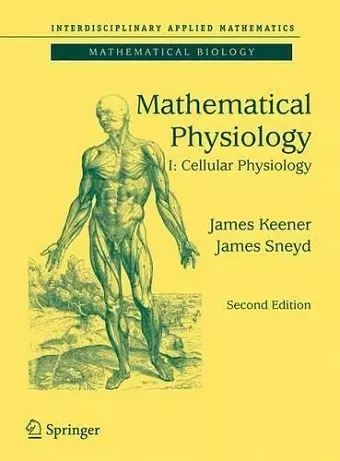Mathematical Physiology
I: Cellular Physiology
James Keener author James Sneyd author
Format:Hardback
Publisher:Springer-Verlag New York Inc.
Published:27th Oct '08
Currently unavailable, our supplier has not provided us a restock date
This hardback is available in another edition too:
- Paperback£54.99(9781489986702)

Divided into two volumes, the book begins with a pedagogical presentation of some of the basic theory, with chapters on biochemical reactions, diffusion, excitability, wave propagation and cellular homeostasis. The second, more extensive part discusses particular physiological systems, with chapters on calcium dynamics, bursting oscillations and secretion, cardiac cells, muscles, intercellular communication, the circulatory system, the immune system, wound healing, the respiratory system, the visual system, hormone physiology, renal physiology, digestion, the visual system and hearing. New chapters on Calcium Dynamics, Neuroendocrine Cells and Regulation of Cell Function have been included. Reviews from first edition: Keener and Sneyd's Mathematical Physiology is the first comprehensive text of its kind that deals exclusively with the interplay between mathematics and physiology. Writing a book like this is an audacious act! -Society of Mathematical Biology Keener and Sneyd's is unique in that it attempts to present one of the most important subfields of biology and medicine, physiology, in terms of mathematical "language", rather than organizing materials around mathematical methodology. -SIAM review
From the reviews:
“Probably the best book ever written on the subject of mathematical physiology … It contains numerous exercises, enough to keep even the most diligent student busy, and a comprehensive list of approximately 600 references … highly recommended to anybody interested in mathematical or theoretical physiology.” Mathematical Reviews
“In addition to being good reading, excellent pedagogy, and appealing science, the exposition is lucid and clear, and there are many good problem sets to choose from … Highly recommended.” Journal of the Society of Mathematical Biology
“Most of the chapters, especially those outined in the second part of the book, can constitute whole monographs by themselves, and Keener and Sneyd have attempted to cover some of the fundamental modeling concepts within the respective areas.” Bulletin of Mathematical Biology, 2000
“Both authors are seasoned experts in the field of mathematical physiology and particularly in the field of excitability, calcium dynamics and spiral waves. It directs students to become not merely skilled technicians in biological research but masters of the science.” SIAM, 2004
From the reviews of the second edition:
"This massive new edition … offers an introduction to mathematical physiology that emphasizes work conducted by Keener (Univ. of Utah), Sneyd (Univ. of Auckland, New Zealand), and others over the past 20 years. It is designed as a course resource for beginning graduate students who have … some mathematical background. … Keener and Sneyd have made very reasonable choices in their subject selections. This work is an admirable resource for students with the appropriate prerequisites. Chapters include exercises … . Summing Up: Recommended. Graduate students." (P. Cull, Choice, Vol. 46 (10), June, 2009)
"The texts provide a comprehensive summary of the important concepts inmathematical physiology. … For those actively working in the field of mathematical physiology … is a must have. The new edition includes updated descriptions, new models, and new figures adding to the breadth of the first edition. One of the most beneficial aspects … is the addition of about a decade’s worth of work and references (over 350!). … more advanced questions were added giving more flexibility when used as a course textbook." (Joe Latulippe, The Mathematical Association of America, July, 2009)
“This second edition of Mathematical physiology, ten years after the first one … provides information on recent works in mathematical physiology. … It is a very interesting book dealing with the interdisciplinary field of mathematical physiology. … Mathematical physiology, with the consequent number of exercises given at the end of each chapter, could be used in particular for a full-year course in mathematical physiology. It is also suitable for researchers and graduate students in applied mathematics, bioengineering and physiology.” (Fabien Crauste, Mathematical Reviews, Issue 201ISBN: 9780387758466
Dimensions: unknown
Weight: unknown
547 pages
2nd ed. 2009